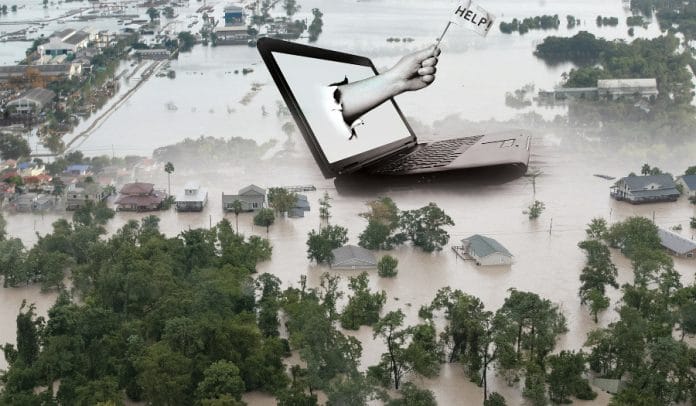Climate change is gathering momentum and because of this, the world has witnessed some of the most devastating disasters recently. Tsunamis, cyclones, floods, earthquakes and even wildfires have destroyed lives and entire regions, of late. So can we look to open source software to help mitigate the effects of these disasters?
A disaster is a sudden accident or catastrophe, like an earthquake, a flood or a fire, which the community is incapable of coping with. It could be a natural or a man-made event, which kills people and destroys goods, services and the environment. In such circumstances, help from the government and information agencies is required.
In disaster risk management (DRM), financing and insurance are two major concerns for the government.
Natural disasters cause damage to human life and property. They result in severe losses. Some recent examples include the Kerala floods, the Northern California fires, hurricanes Irma and Harvey, and the volcanic eruption in Hawaii.
In a disaster situation, aid institutions must keep track of the victims’ needs and respond accordingly. While monitoring large scale disasters, massive amounts of heterogeneous data gets collected and that must be managed efficiently by aid agencies. During a disaster, if information is not handled well, help can get delayed or become ineffective, leading to the potential waste of resources or in uneven aid distribution. FOSS can help manage disasters, and has the potential to improve the efficiency and effectiveness of aid agencies.
During disasters, effective information systems are required because they can provide timely access to comprehensive, relevant and reliable solutions to victims. FOSS for disaster management is in high demand because of its lower cost and higher efficiency.
FOSS in disaster management
The Asia-Pacific region, with 60 per cent of the world’s population, is highly vulnerable to disasters. Between 2002 and 2011, 40 per cent of all reported disasters (1,524) occurred in Asia, causing 63 per cent of all global disaster deaths (669,263), and causing 48 per cent of global damage (costing US$ 691 billion).
FOSS helps the disaster risk management (DRM) team in the following ways:
- Protecting lives
- Protecting property (buildings, infrastructure, etc)
- Protecting livelihoods at the micro-scale and economies at the macro-scale
- Protecting and sustaining the natural environment
As an example, Google came to the rescue during the Uttarakhand floods of 2013 by developing apps to help rescue teams. It launched a crisis map of the flood-hit state to provide quick information on the places affected, relief centres, medical centres and road closures. It also activated a Person Finder tool—a Web based application that helped feed in the names of the people one was looking for, as well as share information about somebody who had been found or rescued. When there was a match for a person being searched for, it was displayed on this app.
For decades, governments and NGOs have relied on private sector solutions to gather and interpret emergency data for disaster response. But, nowadays, they are depending upon cheaper open source technology.
Proprietary software does everything, from providing images and location based on the Geographic Information System (GIS) to centralising government generated data on a command centre dashboard during a crisis. Such solutions have been around for decades but are expensive.
FOSS: Helping disaster victims
In recent years, especially after the 2010 Haiti earthquake, many cities and NGOs are turning to open source technology, which generally doesn’t involve a licence fee to download the software. FOSS disaster management systems are playing an increasingly important role in the rescue and rehabilitation sector as they offer cost-effective coordination for agencies to respond to large scale disasters.
In cases of man-made crises or natural disasters, a range of organisations, websites, open source tools, mobile applications, etc, is available to the public. Some of the FOSS software used in the US during disasters are listed below.
- CDC widgets and gadgets: The Center for Disease Control and Prevention (CDC) now provides a wide range of free software widgets and gadgets focused on public health and safety, for use on computer systems or websites.
- Frontline SMS: This is an award winning, free and open source software product that can turn a laptop or mobile phone into a central communications hub. It has proved to be very useful in emergencies.
- InSTEDD: This is focused on the design and use of open source technology tools to help partners enhance collaboration and improve information flow to deliver better critical services to affected populations during disasters.
- Integrated Public Alert and Warning System (IPAWS): This open platform is an initiative of the Federal Emergency Management Agency (FEMA) of the US Department of Homeland Security.
- Open ISES: This provides tools, instruction materials, etc, for emergency services, the community and others.
- Real-time Outbreak and Disease Surveillance (RODS): This is for public health bio-surveillance and is used to collect and analyse data on diseases in real-time. It has been founded by the Climate Prediction Center (CPC) and the National Library of Medicine.
- Health Alert Network (HAN): The Center for Disease Control (CDC) and the Health Alert Network (HAN) provide health alerts, health advisories, updates and information service messages to state and local health officers, public information officers, epidemiologists, HAN coordinators and health care provider organisations across the US.
Wireless Sensor Networks (WSNs) are widely deployed in disaster management. Managing heterogeneous embedded devices like different processors and memories, as well as operating systems such as embedded Linux, iOS, Android, along with heterogeneous protocols is very important, to provide efficient solutions for the various challenges in disaster management.
HFOSS plays a key role in disaster management
Humanitarian Free Open Source Software (HFOSS) represents the application of FOSS to fix the problems faced by victims in disaster situations.
FOSS helps to save lives and victims by responding to the following:
- Rapid-onset natural disasters such as tsunamis, earthquakes and pandemics
- Slow-onset natural disasters such as global warming, droughts and famine
- Man-made disasters such as civil wars
Some popular HFOSS solutions used in disaster management are:
- Sahana
- Ushahidi
- Open Street Map
- InSTEDD
- Frontline SMS
- Open MRS
- Rapid SMS
There are many more institutions contributing to FOSS. These communities work together effectively to provide better software. Most of these products are based on open source platforms and are built from open source software such as Apache, Linux, PHP, Python, MySQL, etc.
The advantages of HFOSS disaster management solutions are:
- No discrimination with respect to access
- Ability to cross technology borders.
- Can easily empower the local people
- Lower cost
- Transparency and neutrality
- Rapid localisation and adaptability
- Open standards
- Enable inter-organisational development
Sahana is FOSS that aims to provide comprehensive solutions to information management in relief operations, recovery and rehabilitation. It ensures:
- An open access approach
- Low-cost deployment
- Easy adaptability
Sahana was developed by a group of volunteers in Sri Lanka during the Indian Ocean tsunami.
InaSAFE is used in Asia for disaster management. It was developed jointly by developers in Indonesia, Australia and the World Bank. It produces realistic natural hazard impact scenarios for better planning, preparedness and response activities. It provides a simple but rigorous way to combine data from scientists, local governments and communities to provide insights into the likely impacts of future disasters.
Even Facebook is assisting disaster victims to a great extent. Its disaster map provides information about where populations are located, how they are moving and where they are checking in for safety, during a natural disaster.
Disaster management and Big Data
Big Data offers new options for natural disaster management, and can help to visualise, analyse and predict natural disasters. For example, satellite remote sensing technology helps to assess the damage caused by a disaster, can forecast storms, and so on.
Big Data can help to save humans from all kinds of disasters. It can coordinate relief efforts for those who are the most vulnerable. Both crowd-sourcing of data and social media data are contributing greatly in disaster management. Government agencies, though, have been slow in launching their own crowd-sourcing platforms for disaster management.
Social media platforms, including Twitter, YouTube, Foursquare and Flickr, have been contributing significantly in disaster management. Geo-tagged social media data can be collected by streaming the harvest from the APIs provided by the social media companies. Mobile GPS has emerged as an effective means of gathering mobile sensing data because it can be used to detect human mobility and behaviour during large scale natural disasters. Predictive analytics can be a powerful tool for natural disaster management. Sensor data is usually the major source for developing an early warning system.











































































